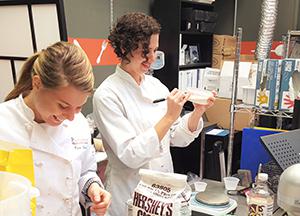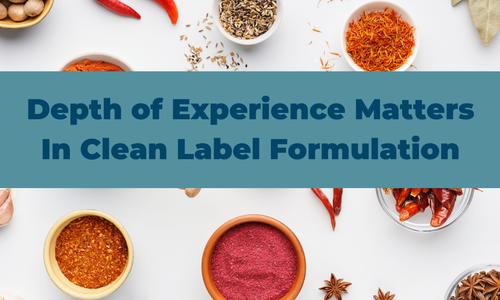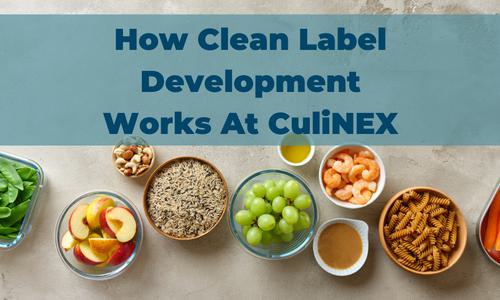
Scaling Commercial Processes on the Bench
How Do You Mimick Commercial Processes?
When developing a food product, often the production processes are just as important as the ingredients themselves. Machinery, process flow, and order of ingredient addition, among other things, play a significant role in how a food product is created. So how are commercial processes replicated on the bench?
While conceptualization is happening, the potential for how the item will be processed needs to be considered. Thinking through the possible production steps will help determine if standard test kitchen equipment can do the work or if pilot plant scaled machinery is needed. The product category will also influence how critical differences between bench equipment and commercial equipment might affect the product. For example, using a Kitchen Aid 5-quart stand mixer has good translatability into Hobart 120-quart stand mixer. Conversely, duplicating twin-screw extrusion or high-pressure pasteurization in a kitchen setting is near impossible.
Let’s develop a cookie and review how the test kitchen can effectively mimic a commercial process. To keep it simple, our cookie will be a simple chocolate chip cookie just like mom used to make.

Scale out ingredients
It is important to be as accurate as possible in scaling out ingredients. A slight loss of accuracy on the bench can translate to large losses of accuracy in product. The accuracy loss can be a financial impact (using more of an expensive minor ingredient than needed) or a product quality impact (not enough or too little of a functional ingredient that causes product failure). The analytical scale itself needs to have a good degree of accuracy. Consider the units of measure to weigh in (kg and g or lb and oz) and how that impacts the ingredients. Consider the degree of accuracy of the scales in the plant and how that impact ingredient proportions.
In our cookie example the fat, flour, and sugar components would be fine to measure on scales with minimum accuracy since those components have high tolerance to variability; they are not likely to cause a product failure if off by a few percent. Ingredients such as vanilla and salt need more accuracy, as they will have greater impact on the flavor of the cookie and product quality. If we were to use a high 2x or 4x vanilla extract, the scale accuracy would be key for product quality.

Batch instructions/Order of ingredients
How the ingredients are combined together can have just as much impact as the ingredients themselves. When batch instructions are not consistent, it makes the scale-up process harder. Ingredients such as gums have premix steps such as the need to be plated on larger amount of miscible ingredients (dry solids or oil) or sheared into a hydrating liquid. They also need to have access to the hydrating liquid for full functionality. If fragile items such as slivered almonds are added in the early stages of a blend, they will have significant more breakage than if they were added at a later stage.
Back to our cookie example. We will need to break down the fat, incorporate the sugar, and add our wet and dry ingredients, in that order. Assume we cream the sugar into the fat, blend in the wet ingredients, and mix in the dry. What temperature does the fat need to be to blend in smoothly? How long do we cream the fat and sugar? What happens if they don’t blend long enough or are blended too long? At what speed and for how long are the wet ingredients blended in? And what about the dry? These variables are easy enough to measure and replicate in a test kitchen environment.

Processing
How the product will be shaped, formed, sheeted, heated/cooled, and otherwise manipulated is important to understand in the development process. Basic production processes can often be replicated on the bench, though without the efficiency of commercial equipment. Is the product going to be baked? Fried? Will it be fermented or pasteurized? Simple processing methods can be easily replicated in a test kitchen, as equipment is readily available and can be easily sourced.
Products that are formed can be reproduced in the test kitchen using handmade molds or adapting molds from another product category. Deli slicers can be used as slicers for more than just meat and cheese items. Food processors can replicate choppers or inline blending systems. Kitchen Aid stand mixers do a good job mimicking commercial paddle blenders.
Our chocolate chip cookie will be 2” in diameter. In development we would need to figure out how much dough, by weight, is needed to make the target finished weight. We also need to know what the cookie spread is from raw dough to cooked dough and the shape the individual cookie. Will it be circular or square? Will it be thick or thin? With the product size variables figured out, we then investigate what kind of machinery we would use in production so we can replicate the results on the bench. To make it easy, assume we use a roller fed dough depositor with a blade cutoff. The roller will give us a slightly compressed product and the blade cutoff will allow us to use larger size chocolate chips than a wire cutoff. This machinery is simple to use and would be easily replicated on the bench. Baking is a standard process so the baking times and temperatures would translate well into commercial production.

Packaging
Packaging in the test kitchen is usually limited to premade bags, bottles, tubs, and trays. An advantage to this is that the test kitchen will be able to bring in a wider variety of packaging for testing and evaluation than a plant can typically produce or test. Premade bags or film can be sealed on simple heat bars. They can also be atmosphere controlled using oxygen scavengers, vacuum, or nitrogen flushing. Trays can easily be sealed with a top film using a household clothes iron.
Our cookies will be single packed in clear pouches. The pouches can be sealed using a standard bar sealer. If we are concerned about shelf life, we can use a small nitrogen tank to flush out the bags.

Storage
Once the test product is produced, it needs to be stored in the appropriate environment. Most items are easy to store in a test kitchen. Refrigeration and freezer space should be easy to come by if the product isn’t produced in large quantities. Ambient storage is as plentiful as there is storage space. All storage types need to be monitored to ensure that they are in the appropriate range. Some food items will degrade faster or will be more susceptible to spoilage if held outside optimal temperatures. Test samples that are meant to be kept around for a long time should have special attention paid to the conditions. A frozen novelty that is susceptible to higher freezing temperatures needs to be held in a freezer with little fluctuation. Since our cookie is a shelf stable product, we can store it cased in boxes at ambient temperatures. If our cookie was of a moist variety, we could hold it a refrigeration to extend its shelf life.
Need Help?
During the development process the consideration of production methods and process flow will have a significant impact on the final product. The more that the processing conditions are addressed in the Test Kitchen, the easier and more seamless commercialization will be. For more information on our commercialization services, contact us today!








